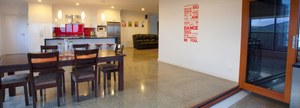- 1. What is polished concrete?
- 2. What is the process?
- 3. Can I choose the aggregate for a new concrete slab?
- 4. What is aggregate?
- 5. Can I colour my polished concrete floor?
- 6. How do I achieve a uniform aggregate finish?
- 7. What options are available if I have an old concrete slab?
- 8. What sealers are applied?
- 9. How much does polished concrete cost?
- 10. When should I liase with a concrete polisher?
- 11. When do you start grinding the floor on a new slab?
- 12. Do I have to have the exposed aggregate look?


The term polished concrete describes a decorative floor finish which leaves the concrete exposed as the final finish. Polished exposed aggregate finishes are achieved by grinding the surface of the slab to expose the aggregate or stones within the concrete or topping mix.
The first step involves grinding the concrete to reveal the aggregate within. The degree of uniformity of exposure needs to be specified. Once a satisfactory level of aggregate exposure is achieved, the concrete is polished using progressively finer grinding pads, then the last step is to polish the concrete with very fine diamond polishing pads???
Yes, if you are laying a new concrete slab. As well as selecting different cement colours in concrete, there are various aggregate colours, types, sizes and minerals to choose for the topping mix. You will need to discuss these options with your concrete supplier.
Aggregate is what is added to cement & sand to make concrete. It can be different from one pour to the next. You can choose from various materials such as rock and glass. Also the aggregate used can be added to the mix in specific, ie. 50% white marble at 20mm , 30% brown rock at 14mm and 20% black rock at 10mm. You can also have your concreter chicken feed in a specific aggregate.
Yes, if you are laying a new slab, there are different cement colours to choose from, which you will need to discuss with your concrete supplier. Please also note that you can change the colour of the sand in the concrete mix to alter the colour of the slab.
The uniformity of the finished floor is determined by the distribution of the aggregate in the concrete.
Depending on the state and level of damage to the concrete floor, the option is to grind and polish the concrete. The overall look will depend upon the type of concrete MPa of the slab and the aggregate density.
We use an exclusive diamond polish process creating a high gloss finish without the use of film coat sealer when doing a Hiperfloor Polished concrete Job. On occasions we can seal a floor with a clear coating if it is what the customer desires or if the customer wants a non-slip additive, it is all dependant on the finish required.
The price varies according to the condition of the slab, the size of the area, the level of grinding required, the aggregate exposure desired and the final finishing sealer. Polished concrete is a cost effective alternative comparable to timber, tiles, carpet, vinyl, pavers etc. Prices to suit your particular project are available on enquiry.
At the very earliest planning stage is best and can provide cost benefits to the client. It is best if you can contact us before the slab has been poured (this is in extensions and new slabs) so we can consult with your concreter, to make sure you will be able to obtain the look you are after.
It is more cost effective for the client to have the main area ground on a new slab before wall frames go up. On old concrete we will need to assess the slabs condition as early as possible. Choosing Different concrete colours may alter the timeframe of when we need to get on the slab to start grinding, so you will need to specify this also.
No, If laying a new slab you can obtain any finish you desire. If polishing an old concrete slab you can choose to have full aggregate, medium exposure or nil exposure, but this also depends on the condition and mix of the old concrete. The overall look is completely up to the customer.

